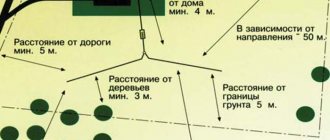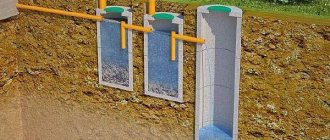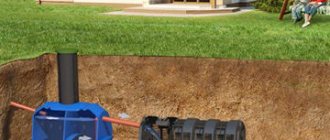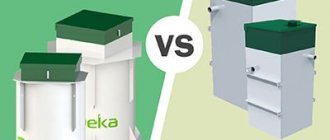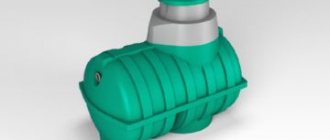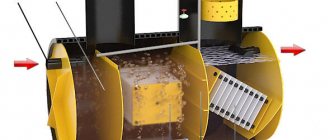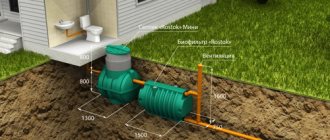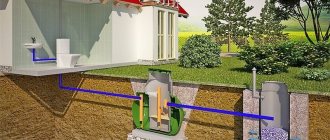Cesspool or septic tank - which is better? A pressing problem if you are planning your own sewerage system on the site. We will tell you in this article how a septic tank differs from a cesspool.
In order to make your stay at the dacha comfortable, you need to properly install the drainage system. If connecting to the central network is not possible, try to find other solutions.
Today, various options for cesspools and septic tanks are available. The choice is difficult, because they have their pros and cons, as well as features in terms of choosing the location, volume and method of waste disposal:
- The arrangement of a cesspool is quite simple, but the inconvenience of operation is associated with the need to periodically pump out the contents of the tank. And if the location is incorrect, there is a high risk of groundwater contamination;
- Installing a septic tank is also possible with your own hands, but caring for it is somewhat specific.
Each sewerage system, be it a pit or a septic tank, needs its own maintenance and cleaning. Also, don’t forget about wastewater; cleaning storm drains will significantly help you reduce the cost of pumping out sewage, and save you from surprises with spills during rainstorms and floods.
Content
- What is the difference between a septic tank and a cesspool?
- Septic tank made of rings - pros and cons
- Cesspool - pros and cons
- What is better for installing local sewerage in a private house - a septic tank or a cesspool?
To ensure comfortable living conditions in private homes and summer cottages, an effective sewer system is necessary. In the absence of centralized drainage, the construction of a local sewerage system will be required, the functions of which will be performed by a cesspool or septic tank. The choice of the optimal option depends on the number of residents, their frequency of residence in the building and other factors.
What is the difference between a septic tank and a cesspool?
A cesspool is a sewerage structure for collecting wastewater. It can be filtration (absorbing) or sealed. Most often there are filtration structures with side walls and an overlap. The bottom is a crushed stone layer through which the liquid part of the waste seeps into the ground. Perforated walls, which are made of brick or perforated concrete rings, help improve fluid drainage. Viscous and large particles remaining in the container are removed using sewer equipment. Compared to filtration structures, sealed cesspools require pumping out wastewater much more often.
The main difference between a septic tank and a cesspool is the combination in a septic tank of gravitational settling of wastewater with biological treatment using bioenzyme preparations, post-treatment by natural and forced methods. Such systems consist of several chambers, through which sewage waste is purified to a state that is safe for the environment. To remove the thick, heavy part of the wastewater, they resort to the services of sewage disposal equipment.
Recommendations for cleaning tanks
The procedure for cleaning the drainage pit can be done independently or with the assistance of a sewage disposal machine, the order of which costs money. However, using this technique, it will not be possible to completely solve the problem of removing sewage from the pit. After all, the machine pumps out only liquid waste, and all the sediment remains at the bottom. Therefore, after a certain time, the need for pumping will arise more and more often.
Preparations specially created for cleaning cesspools help solve this problem. During the warm season, it is recommended to use environmentally friendly biological activators, which are highly effective. The products contain microorganisms that accelerate the breakdown of organic substances contained in waste. Biological products can only work at positive temperatures from 4 to 30 degrees.
In winter, it is recommended to use chemical agents - nitrate oxidizers. However, it is very difficult to call them completely safe.
Septic tank made of rings - pros and cons
A septic tank made of concrete rings is a common type of local sewer system for country houses and cottages. Its design includes reinforced concrete rings, a bottom and a floor slab. The diameter of the rings is 1.0 or 1.5 m, height - from 0.75 m. Its design feature is the presence of several wells - from two to five, connected to each other by overflow pipes.
Principle of operation:
- In the first chamber, gravitational settling of wastewater occurs, as well as its treatment with anaerobic bacteria, the life of which does not require the presence of oxygen. Heavy particles settle to the bottom, and partially clarified water flows through an overflow pipe into the next well.
- In the second sealed well, the cleaning process continues.
- After the second chamber, the clarified wastewater is directed to a drainage well or to drainage fields, for the construction of which crushed stone, geotextile, and perforated pipes are used.
Advantages of septic tanks made of concrete rings:
- the ability to achieve a sufficiently high degree of sewage treatment , which ensures their hygienic and environmental safety;
- non-volatile – the system operates without connection to electrical sources;
- absence of pungent odors in the area due to processes of disinfection and decomposition of organic substances that neutralize gases;
- durability if the installation and operation rules are followed.
Disadvantages of septic tanks made of concrete rings:
- complexity of installation , which requires lifting equipment;
- the complexity of installing systems with filtration fields in clay soils and at high groundwater levels;
- the need to purchase microorganisms that ensure the decomposition of waste into safe components;
- significant areas required for a multi-chamber system.
How are they arranged?
Let's figure out how waste disposal plants work. We will consider only the simplest options that are easy to build yourself.
Drain pit device
Making a waste tank of this type is very simple; you need to:
- dig a hole;
- at a depth below the freezing level, install a sealed container or concrete the bottom and walls;
- a pipe is connected to the constructed or installed tank through which wastewater will flow from the house;
- It is recommended to lay a ceiling over the pit, in which a hole will be left for cleaning the tank. The hole is closed with a lid.
Advice! For convenience, you can equip the pit with a simple alarm. To do this, a float sensor is placed inside, connected to a lamp mounted on top. When the pit is filled, the alarm will go off and the owners will only have to call a vacuum truck.
Septic tank installation
This treatment plant has a more complex structure. The standard scheme includes the following elements:
- primary settling tank-receiver;
- secondary settling tank;
- filter well or other device for performing post-treatment.
The first two elements must be sealed, in which the wastewater gradually settles, freeing itself from undissolved inclusions. In order for the water to have time to settle well, it is necessary to make the tanks large enough. It is believed that settling should take at least 72 hours. Therefore, the tanks must accommodate at least three days of wastewater generated in the house.
In this case, the receiving chamber should be the most spacious. If we are talking about a two-chamber installation, then the receiver should account for 75% of the total volume. The tanks are connected by overflow devices.
Cesspool - pros and cons
There are few advantages to a cesspool, the main one being ease of construction and low financial costs for construction. But its operation has a large number of disadvantages. The disadvantages of sealed containers are the need to frequently call sewage disposal equipment and the strong smell from decomposing wastewater. Filtration-type pits require less frequent pumping, but they have other disadvantages:
- The main disadvantage is that all waste seeps into the ground without purification or with a low level of purification (when passing through a small drainage layer), which pollutes the environment and poses a great danger from a sanitary and hygienic point of view.
- When pumping, it is necessary to clean or replace the drainage layer to improve throughput. With a sufficiently thick drainage layer, its periodic cleaning and low groundwater, such a structure poses a moderate threat to the environment.
- To locate the cesspool, you must choose a suitable location. In accordance with sanitary standards, it must be located at a distance of at least 30 m from a drinking source.
Characteristic disadvantages of local stations of the “Topas” type
The main disadvantage of branded septic tanks is their relatively high cost and long commissioning time. It takes several months for activated sludge to reach operating conditions.
Malfunctions of the electronic control unit are most often the result of sudden voltage drops, therefore, for trouble-free operation of the built-in electronics, it is recommended to connect the power through a stabilizer.
There is a need for a constant influx of wastewater and renewal of the processed volume. Failure to comply with this recommendation inevitably leads to a decrease in the intensity of processing and even to its complete stop.
This feature of aerobic septic tanks determines their suitability for permanent use in areas with permanent residence of their owners. The processing of wastewater by aerobic bacteria slows down significantly or completely stops with a high content of chlorine, washing solutions, acidic and alkaline chemical compounds.
What is better for installing local sewerage in a private house - a septic tank or a cesspool?
Installing a septic tank made of concrete rings is one of the most reliable options for constructing an autonomous sewer system. A multi-chamber treatment system can provide comfortable year-round living for a family of three to five people. If you have a large garden, purified water is used for irrigation.
If one or two people periodically go to the dacha, installing a sealed tank is quite enough. The most dangerous for the environment is a filtration cesspool, from which wastewater enters the environment without sufficient treatment.



